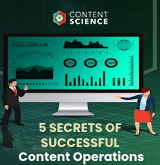
We finally made it to 2021. And your content approach likely looks a lot different than what you had on the books at the start of last year.
As COVID-19 ravaged the world, it upended how we do business along the way. Digital disruption accelerated at an unprecedented pace. For example, more digital disruption happened in retail in eight weeks last spring than in the past 10 years combined.
With the content industry evolving to meet new challenges, we asked content thought leaders to weigh in on their content predictions and plans for the year ahead.
Read on to get content predictions and insights from content strategists, user experience architects, journalists, and other experts.
Content Trust
Michael Haggerty-Villa, Intuit: “In the design systems community, there are plenty of reminders that design systems are for people. I like to think that a human focus has always been a part of the content community. As we step out of the shadows of a dark year, I’m hoping content designers and strategists continue to lean into this strength. What does that look like? It means things like standing up for and creating good content and design that help people. It also means calling out harmful, misleading, or biased content. We can do better, and I look forward to seeing more systemic approaches to getting us there.”
Gary Schwitzer, HealthNewsReview.org: “Prediction: Donald Trump will continue to spew misinformation in 2021. Priority: Journalists should learn from the past four years and stop providing a megaphone (MAGAphone?) to lies, distortions, and claims of ‘fake news.’”
Read more from Gary Schwitzer: Health and Science Communication in the COVID Era: A Q&A With the Publisher of Health News Review
Content Design
Justin Clemens, Meredith Deaver, Jonelle Wilkinson-Seitz, AT&T: “For 2021, our priority is defining a central source of truth for customer-centric digital content. To bring that vision to life, we’ll align with internal teams across brands, disciplines, and channels to help create consistent, relevant, tested, and ‘write-once, use-many’ content. As part of this effort, we’re exploring ways to operationalize inclusive, ethical, and accessible content design. The game plan: standardize frameworks and playbooks for a multitude of content creators, integrate automation tools for speed, and set up a democratic system of governance for quality control.”
Jacy Garraway, Vanguard: “We’ll broaden our practice of designing for accessibility and inclusion by partnering closely with the research team to gain greater awareness of the different ways people use and experience our products and services. Codifying our findings in the content portion of the design system will also be a priority to best enable our team to meet the needs of our clients and create consistent and accessible content across the experience.”
Content Voice and Tone
Christoher Willis, Acrolinx: “For almost the last decade, vendors have been telling customers to ‘get ready for the Digital Shift.’ Back in March, though, the Digital Shift slid from the future to the present, as the vast majority of consumers started interacting entirely online. As a result, the content touch points that deliver the digital customer experience have risen to become a top priority in the global enterprise. As a result, we expect that 2021 will bring with it a new customer experience leader on the executive team. This leader will be responsible for the voice of the company across all channels. The most successful companies will be the ones that can communicate with their consumers in a single voice across all channels.”
Joseph Dickerson, ZoomInfo: “A key priority for the content that the experiences my team produces is a variation of the Hippocratic Oath: ‘First, do no harm.’ People have been stressed in multiple ways the last year, and I do not want any off-putting content or information that is presented in the wrong tone of voice to increase that anxiety. So I’m particularly focused on making sure information is helpful and directly aligned to what people need to do. I’ve often said that if we produce an effective application or system, it will mean that someone somewhere will go home with a little less frustration than they would have felt otherwise. They won’t yell at their partner, or kick their dog. It may be a Pollyanna view, but that’s how I feel.”
Read more from Joseph Dickerson: The Future of Content Experience: UX Trends to Look For in 2020
Content Predictions for Strategy
Lance Yoder, Cerner: “I’m answering it in the context of the applications our team manages that are focused on internal/employee content. My content predictions for 2021 include that AI will continue to become reality for content. Beyond just chat bot improvements, things like modeling content in such a way that it can be analyzed and can train a system so that actions can be automated on that content. My priority for 2021 is content portability. Enabling employees to collaborate and find information from anywhere, and in the manner of their preference (whether on mobile, desktop, or specific applications.”
Paula Ludmann, American Academy of Dermatology: “2020 shifted our content strategy greatly and for the better. To meet the content needs of our member dermatologists and the public, our organization put aside its annual editorial calendars to develop content that our target audiences sought. I anticipate that this flexibility is here to stay. Because content needs will likely (and hopefully) be less obvious than the demand for scientific news about COVID-19, we will use advanced data analytics to monitor what content resonates with our audiences. We’re also planning a full-scale content audit to gauge the diversity and inclusiveness of our public content. To reduce health disparities, it’s imperative that medical content be inclusive of diverse populations.”
Read more from Paula Ludmann: 6 Steps for When You Suddenly Need To Shift Content Gears
Events, Resources, + More
5 Secrets of Content Ops Success: Webinar
Learn how the most successful organizations scale and mature content operations. Based on our research with 700+ content leaders and professionals.
The Ultimate Guide to End-to-End Content
Discover why + how an end-to-end approach is critical in the age of AI with this comprehensive white paper.
The Content Advantage Book
Learn more about the much-anticipated third edition of the highly rated book by Colleen Jones. Preorder the electronic version.
20 Signs of a Content Problem in a High-Stakes Initiative
Use this white paper to diagnose the problem so you can achieve the right solution faster.
Workshop: Are You Ready for AI?
Is your organization really ready for AI at scale? Let the Content Science team guide your leaders through assessing 4 areas of readiness.
Upskill with Content Science Academy
Training for modern content roles through on-demand certifications + courses or live workshops.








Comments
We invite you to share your perspective in a constructive way. To comment, please sign in or register. Our moderating team will review all comments and may edit them for clarity. Our team also may delete comments that are off-topic or disrespectful. All postings become the property of
Content Science Review.